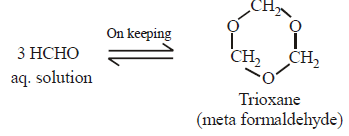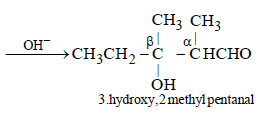31 Year NEET Previous Year Questions: Aldehydes, Ketones & Carboxylic Acids - 3 - NEET MCQ
25 Questions MCQ Test - 31 Year NEET Previous Year Questions: Aldehydes, Ketones & Carboxylic Acids - 3
If formaldehyde and KOH are heated, then we get [1988]
Formalin is an aqueous solution of [1988]
| 1 Crore+ students have signed up on EduRev. Have you? Download the App |
Which of the following is the correct decreasing order of acidic strength of [1988]
(i) methanoic acid (ii) ethanoic acid
(iii) propanoic acid (iv) butanoic acid.
(i) methanoic acid (ii) ethanoic acid
(iii) propanoic acid (iv) butanoic acid.
Among the following the strongest acid is [1988]
The compound formed when malonic ester isheated with urea is [1989]
The above shown polymer is obtained when acarbonyl compound is allowed to stand. It is awhite solid. The polymer is [1989]


The above compound describes a condensation polymer which can be obtained in two ways : either treating 3 molecules of acetone (CH3COCH3) with conc. H2SO4 or passing propyne (CH3 C ≡ CH) through a red hot tube.
The polymer is [1989]


This polymer (B) is obtained when acetone issaturated with hydrogen chloride gas, B can be [1989]
The reagent (s) which can be used to distinguishacetophenone from benzophenone is (are) [1990]
Acetaldehyde reacts with [1991]
In which of the following, the number of carbonatoms does not remain same when carboxylic acidis obtained by oxidation [1992]
Benzoic acid gives benzene on being heated withX and phenol gives benzene on being heatedwith Y. Therefore X and Y are respectively [1992]
Sodium formate on heating yields [1993]
Among acetic acid, phenol and n-hexanol, whichof the following compounds will react withNaHCO3 solution to give sodium salt and carbondioxide ? [1993]
(CH3)2 C = CHCOCH3 can be oxidized to (CH3)2C = CHCOOH by [1993]
Pinacolone is [1994]
Benzaldehyde reacts with ethanoic KCN to give[1994]
Aldehydes and ketones will not form crystallinederivatives with [1994]
Which of the following compound will undergoself aldol condensation in the presence of colddilute alkali ? [1994]
Formic acid is obtained when [1994]
The preparation of ethyl acetoacetate involves[1994]
Schotten-Baumann reaction is a reaction ofphenols with [1994]
An ester is boiled with KOH. The product iscooled and acidified with concentrated HCl. Awhite crystalline acid separates. The ester is[1994]
Acetone reacts with iodine (I2) to form iodoformin the presence of [1995]
In the Freidel Craft's acylation reaction, theeffective electrophile is [1996]














 COOH. The only reagent suitable for this conversion is NaOI or NaOH + I2 (iodoform
COOH. The only reagent suitable for this conversion is NaOI or NaOH + I2 (iodoform


























